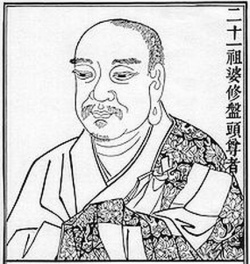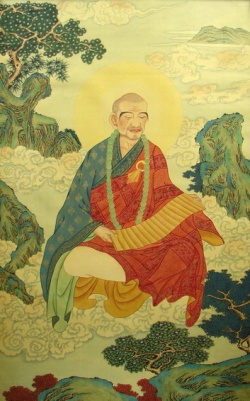Vasubandhu
Vasubandhu(Skt.; Tib. དབྱིག་གཉེན་, Yiknyen; Wyl. dbyig gnyen) numbers among the ‘Six Ornaments’, the greatest Buddhist authorities of Ancient India.
He was the younger brother of Asanga, and composed The Treasury of Abhidharma (Skt. Abhidharmakosha), a complete and systematic account of the Abhidharma,
the peak of scholarship in the Fundamental Vehicle.
Later he followed the Mahayana Yogachara view, and wrote many works, such as Thirty Stanzas on the Mind (Trimsikavijñapti-karika)
His Writings
- Abhidharmakosha
- Analysis of the Five Skandhas
- Thirty Stanzas
- Treatise on Karma
- Treatise on the Three Natures
- Twenty Stanzas
- Well Explained Reasoning
His Disciples
He famously had four students who were more learned than himself: Sthiramati, who was more learned in Abhidharma; Dignāga, who was more learned in Pramāṇa; Guṇaprabha, who was more learned in the Vinaya; and Arya Vimuktasena, who was more learned in Prajñāpāramitā.
Further Reading
Lobsang N. Tsonawa, Indian Buddhist Pandits from The Jewel Garland of Buddhist History, Dharamsala: Library of Tibetan Works and Archives, 1985.
- Stefan Anacker, Seven Works of Vasubandhu: The Buddhist Psychological Doctor, Motilal Banarsidass, 2nd Edition, 2002}}
External Links
Source
Vasubandhu (Sanskrit: वसुबन्दु; traditional Chinese: 世親; pinyin: Shìqīn; Tibetan: དབྱིག་གཉེན་, Wylie: dbyig gnyen) (fl. 4th c.) was an Indian Buddhist monk, and along with his half-brother Asanga, one of the main founders of the Indian Yogācāra school.
However, some scholars consider Vasubandhu to be two distinct people.
Vasubandhu is one of the most influential figures in the entire history of Buddhism. In the Jodo Shinshu branch of Buddhism, he is considered the Second Patriarch. In Zen, he is the 21st Patriarch.
Biography
Born a brahmin Vasubandhu was said to have been the half brother of Asanga, another key personage in the founding of the Yogacara School.
He was also, as well as his elder half brother Asanga, one of the ‘Six Ornaments ’(i.e. six great commentators on the Buddha’s teachings).
He resided at Kausambhi (near modern Allahabad) where he was trained in the orthodox Sarvastivada Order of Buddhism, which had its seat at Kausambhi.
He was contemporaneous with King Chandragupta I, the father of Samudragupta. This information temporally places this Vasubandhu in the fourth century CE.
Vasubandhu is said to have trained in the Vaibhāṣika-Sarvāstivādin when he initially studied Vaibhashika-Sarvāstivādin Abhidharma, as presented in the Mahā-vibhāsa.
Dissatisfied with those teachings, he wrote a summary of the Vaibhashika perspective in the Abhidharmakośa in verse and an auto-commentary, the Abhidharmakośa-bhāsya, which summarized and critiqued the Mahāvibhāsa from the Sautrāntrika viewpoint.
He is later said to have converted to the Mahāyāna tradition under the influence of his brother, whereupon he composed a number of voluminous treatises, especially on Yogācāra doctrines.
Most influential in the East Asian Buddhist tradition have been Vimśatikāvijñaptimātratāsiddhi, the "Twenty Verses on Representatio Only" and the Triṃśikā-vijñaptimātratā, the "Thirty Verses on Representation-only".
These two texts are companions. Vasubandhu also wrote a large number of other works, including:
- Commentary to the Mahāyāna-samgraha
- Daśabhūmika-bhāṣya (Ten Stages Sutra)
- Catuhśataka-śāstra
- Mahāyāna śatadharmā-prakāśamukha śāstra
- Amitayus sutropadeśa
- Discourse on the Pure Land
- Vijnaptimatrata Sastra
- Karmasiddhiprakarana (A Treatise on Action)
And Buddhist logic
Vasubandhu contributed to Buddhist logic and is held to have been the origin of formal logic in the Dharmic logico-epistemological tradition.
Vasubandhu was particularly interested in formal logic to fortify his contributions to the traditions of dialectical contestability and debate. Anacker (2005: p. 31) holds that:
- A Method for Argumentation (Vāda-vidhi) is the only work on logic by Vasabandhu which has to any extent survived. It is the earliest of the treatises known to have been written by him on the subject.
This is all the more interesting because Vāda-vidhi marks the dawn of Indian formal logic.
The title, "Method for Argumentation", indicates that Vasabandhu's concern with logic was primarily motivated by the wish to mould formally flawless arguments, and is thus a result of his interest in philosophical debate.
Two Vasubandhus
Erich Frauwallner, a mid-twentieth century Buddhologist, sought to distinguish two Vasubandhus, one the Yogācārin and the other a Sautrāntika, but this view has largely fallen from favour in part on the basis of the anonymous Abhidharma-dīpa, a critique of the Abhidharmakośa which clearly identifies Vasubandhu as the sole author of both groups of writings.
According to Dan Lusthaus, "Since the progression and development of his thought ... is so strikingly evident in these works, and the similarity of vocabulary and style of argument so apparent across the texts, the theory of Two Vasubandhus has little merit." There is no scholarly consensus on this question at present.
Source
Vasubandhu
世親・天親 (n.d.) (Skt; Jpn Seshin or Tenjin)
A Buddhist scholar in India thought to have lived around the fourth or fifth century.
He is known as the author of The Dharma Analysis Treasury. Vasubandhu was born to a Brahman family in Purushapura of Gandhara in northern India.
He had an older brother, Asanga. In the central Indian city of Ayodhya, he studied the doctrine of the Sarvastivada school and lectured on The Great Commentary on the Abhidharma, the primary text of that school.
He compiled these lectures as The Dharma Analysis Treasury, which presents a comprehensive discussion of the Sarvastivada thought.
Thus he became the undisputed master of Hinayana philosophy in India at the time.
Vasubandhu at first criticized Mahayana, but later converted to it through the influence of his brother Asanga, whom he assisted thereafter in promoting the Yogachara, or Consciousness-Only, school of Mahayana.
Vasubandhu is said to have written a thousand works, five hundred related to Hinayana and five hundred to Mahayana.
Among those that have survived are The Twenty-Stanza Treatise on the Consciousness-Only Doctrine, The Treatise on the Ten Stages Sutra, The Treatise on the Lotus Sutra, The Commentary on "The Summary of the Mahayana," and The Treatise on the Buddha Nature.
He is counted as the twentieth of Shakyamuni's twenty-three, or the twenty-first of his twenty-four, successors.


